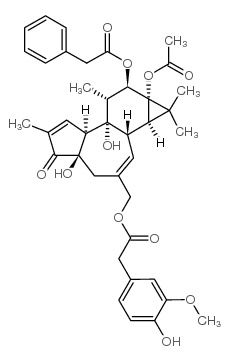PPAHV

PPAHV structure
|
Common Name | PPAHV | ||
|---|---|---|---|---|
| CAS Number | 175796-50-6 | Molecular Weight | 688.76000 | |
| Density | 1.36g/cm3 | Boiling Point | 792.4ºC at 760mmHg | |
| Molecular Formula | C39H44O11 | Melting Point | N/A | |
| MSDS | Chinese USA | Flash Point | 241.1ºC | |
|
Characterization using FLIPR of rat vanilloid receptor (rVR1) pharmacology.
Br. J. Pharmacol. 130(4) , 916-22, (2000) The vanilloid receptor (VR1) is a ligand-gated ion channel, which plays an important role in nociceptive processing. Therefore, a pharmacological characterization of the recently cloned rat VR1 (rVR1) was undertaken. HEK293 cells stable expressing rVR1 (rVR1-... |
|
|
Pharmacology of vanilloids at recombinant and endogenous rat vanilloid receptors.
Biochem. Pharmacol. 65(1) , 143-51, (2003) This study compared the actions of members of five different chemical classes of vanilloid agonists at the recombinant rat vanilloid VR1 receptor expressed in HEK293 cells, and at endogenous vanilloid receptors on dorsal root ganglion cells and sensory nerves... |
|
|
Identification of species-specific determinants of the action of the antagonist capsazepine and the agonist PPAHV on TRPV1.
J. Biol. Chem. 279(17) , 17165-72, (2004) The vanilloid receptor 1 (VR1 or TRPV1) ion channel is activated by noxious heat, low pH and by a variety of vanilloid-related compounds. The antagonist, capsazepine is more effective at inhibiting the human TRPV1 response to pH 5.5 than the rat TRPV1 respons... |
|
|
Synthesis and evaluation of phorboid 20-homovanillates: discovery of a class of ligands binding to the vanilloid (capsaicin) receptor with different degrees of cooperativity.
J. Med. Chem. 39 , 3123-3131, (1996) A number of phorboid 20-homovanillates were prepared by condensation of phorbol 12,13-diesters and 12-dehydrophorbol 13-esters with Mem-homovanillic acid followed by removal of the protecting group with SnCl4 in THF. These compounds were evaluated for their a... |
|
|
A novel agonist, phorbol 12-phenylacetate 13-acetate 20-homovanillate, abolishes positive cooperativity of binding by the vanilloid receptor.
Eur. J. Pharmacol. 299 , 221, (1996) Capsaicin binds to a specific recognition site, referred to as the vanilloid receptor, which it shares with the natural, ultrapotent agonist resiniferatoxin and with the competitive antagonist capsazepine. Upon binding to its receptor, capsaicin opens a catio... |
|
|
A non-pungent resiniferatoxin analogue, phorbol 12-phenylacetate 13 acetate 20-homovanillate, reveals vanilloid receptor subtypes on rat trigeminal ganglion neurons.
Neuroscience 84 , 569, (1998) Capsaicin, the vanilloid responsible for the pungent taste of hot peppers, binds to receptors found primarily in polymodal nociceptors. Capsaicin initially stimulates polymodal nociceptors and subsequently inhibits them from responding to a variety of stimuli... |
|
|
Pharmacological differences between the human and rat vanilloid receptor 1 (VR1).
Br. J. Pharmacol. 132(5) , 1084-94, (2001) Vanilloid receptors (VR1) were cloned from human and rat dorsal root ganglion libraries and expressed in Xenopus oocytes or Chinese Hamster Ovary (CHO) cells. Both rat and human VR1 formed ligand gated channels that were activated by capsaicin with similar EC... |
|
|
Phorboid 20-homovanillates induce apoptosis through a VR1-independent mechanism.
Chem. Biol. 7(7) , 483-92, (2000) Vanilloids, such as capsaicin and resiniferatoxin (RTX), are recognized at the cell surface by vanilloid receptor type 1 (VR1), which has recently been cloned. VR1 mediates the effects of capsaicin and RTX in VR1-expressing cells, but vanilloids can induce ap... |
|
|
Molecular determinants of vanilloid sensitivity in TRPV1.
J. Biol. Chem. 279(19) , 20283-95, (2004) Vanilloid receptor 1 (TRPV1), a membrane-associated cation channel, is activated by the pungent vanilloid from chili peppers, capsaicin, and the ultra potent vanilloid from Euphorbia resinifera, resiniferatoxin (RTX), as well as by physical stimuli (heat and ... |
|
|
Respiratory actions of vanilloid receptor agonists in the nucleus of the solitary tract: comparison of resiniferatoxin with non-pungent agents and anandamide.
Br. J. Pharmacol. 137(6) , 919-27, (2002) 1. Activation of vanilloid receptors on sensory nerve terminals in the commissural nucleus of the solitary tract (cNTS) of rats with capsaicin, produces respiratory slowing. In this study, we used microinjection techniques employing pungent and non-pungent va... |